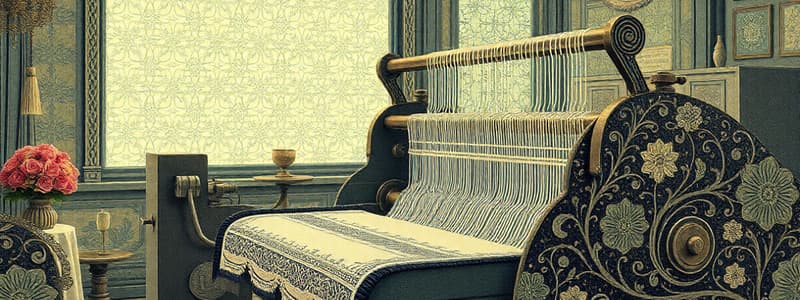Podcast
Questions and Answers
What is the purpose of the guides overlapping across the beards during the knitting cycle?
What is the purpose of the guides overlapping across the beards during the knitting cycle?
- To increase the swing of the guide-bar
- To reduce the time required for the knitting process (correct)
- To allow for the descent of the needle bar
- To prevent the needles from rising to full height
During the pressing stage of the knitting cycle, what happens after the needle bar descends?
During the pressing stage of the knitting cycle, what happens after the needle bar descends?
- The sinkers withdraw to create space
- The presser advances and closes the beards (correct)
- The beards open to release the overlaps
- The old overlaps are knocked-over
What is the result of the sinkers moving forward at the end of the knitting cycle?
What is the result of the sinkers moving forward at the end of the knitting cycle?
- They release the fabric loops and allow for needle ascent
- They assist in increasing the guide-bar swing
- They allow the old overlaps to slip off the beards
- They hold down the fabric loops and push them away from the ascending needles (correct)
What occurs during the knock-over and underlap shog process?
What occurs during the knock-over and underlap shog process?
What is a common occurrence of the underlap shog during the knitting cycle?
What is a common occurrence of the underlap shog during the knitting cycle?
What component of a tricot machine is responsible for maintaining tension in the warp threads?
What component of a tricot machine is responsible for maintaining tension in the warp threads?
Which part of the tricot machine is responsible for driving the knitting elements?
Which part of the tricot machine is responsible for driving the knitting elements?
What determines the gauge of needles on a tricot machine?
What determines the gauge of needles on a tricot machine?
How do guides in a tricot machine receive lateral motion?
How do guides in a tricot machine receive lateral motion?
What is the primary function of sinkers in a tricot machine?
What is the primary function of sinkers in a tricot machine?
During the knitting cycle, what position do the needles rise to?
During the knitting cycle, what position do the needles rise to?
What material is commonly used for fabric take-up rollers in a tricot machine?
What material is commonly used for fabric take-up rollers in a tricot machine?
What mechanism closes the beard of the needle during loop formation in beard needle machines?
What mechanism closes the beard of the needle during loop formation in beard needle machines?
What is the primary outcome of the guides swinging to the front during the knitting cycle?
What is the primary outcome of the guides swinging to the front during the knitting cycle?
What does the descent of the needle bar during the pressing stage accomplish?
What does the descent of the needle bar during the pressing stage accomplish?
What role does the presser play during the knitting cycle?
What role does the presser play during the knitting cycle?
During which stage does the knock-over occur in relation to the sinkers?
During which stage does the knock-over occur in relation to the sinkers?
What typically happens during the underlap shog in the knitting cycle?
What typically happens during the underlap shog in the knitting cycle?
What component is responsible for carrying the warp threads in a tricot machine?
What component is responsible for carrying the warp threads in a tricot machine?
Which of the following is NOT a function of the sinkers in a tricot machine?
Which of the following is NOT a function of the sinkers in a tricot machine?
What mechanism provides motion to the needles mounted in the needle bar?
What mechanism provides motion to the needles mounted in the needle bar?
What typically determines the width of a tricot machine?
What typically determines the width of a tricot machine?
In a tricot machine, what happens to the presser during the knitting cycle?
In a tricot machine, what happens to the presser during the knitting cycle?
How many guide bars are usually provided on a tricot machine?
How many guide bars are usually provided on a tricot machine?
What part of the tricot machine winds up the fabric on large rolls?
What part of the tricot machine winds up the fabric on large rolls?
What type of motion do the guides receive from the main cam shaft in a tricot machine?
What type of motion do the guides receive from the main cam shaft in a tricot machine?
Flashcards
Tricot Machine Parts
Tricot Machine Parts
Tricot machines have warp beams, sley bars, tension bars, knitting elements (guides, sinkers, needles, presser bar), fabric take-up rollers, and a batch roller.
Knitting Elements
Knitting Elements
The knitting elements include needles, warp guides, sinkers, and a presser bar. These are crucial for fabric formation.
Needles (Tricot)
Needles (Tricot)
Needles are mounted in a bar, and the bar is driven by the main cam. The gauge (number of needles) determines the machine width.
Warp Guides
Warp Guides
Signup and view all the flashcards
Sinkers
Sinkers
Signup and view all the flashcards
Presser
Presser
Signup and view all the flashcards
Knitting Cycle (Rest Position)
Knitting Cycle (Rest Position)
Signup and view all the flashcards
Knitting Cycle (Backward Swing)
Knitting Cycle (Backward Swing)
Signup and view all the flashcards
Overlap Guides
Overlap Guides
Signup and view all the flashcards
Guide Swing and Rise (c, d)
Guide Swing and Rise (c, d)
Signup and view all the flashcards
Pressing (e)
Pressing (e)
Signup and view all the flashcards
Landing (f)
Landing (f)
Signup and view all the flashcards
Knock-over and Underlap Shog (g)
Knock-over and Underlap Shog (g)
Signup and view all the flashcards
What does the guide swing accomplish?
What does the guide swing accomplish?
Signup and view all the flashcards
What is the purpose of the presser?
What is the purpose of the presser?
Signup and view all the flashcards
What does landing mean?
What does landing mean?
Signup and view all the flashcards
What is the knock-over shog?
What is the knock-over shog?
Signup and view all the flashcards
Why is the underlap shog important?
Why is the underlap shog important?
Signup and view all the flashcards
Tricot Machine: What is it?
Tricot Machine: What is it?
Signup and view all the flashcards
Tricot Machine: Key Parts
Tricot Machine: Key Parts
Signup and view all the flashcards
Tricot Knitting: Needles
Tricot Knitting: Needles
Signup and view all the flashcards
Tricot Knitting: What do guides do?
Tricot Knitting: What do guides do?
Signup and view all the flashcards
Tricot Knitting: What are sinkers?
Tricot Knitting: What are sinkers?
Signup and view all the flashcards
Tricot Knitting: Presser Bar
Tricot Knitting: Presser Bar
Signup and view all the flashcards
Study Notes
Tricot Machine Technology
- Tricot machines are used in knitting technology
- The machine has several key components
- Key components include warp beams, sley bars, tension bars, knitting elements, fabric take-up rollers, and a batch roller.
- The warp beam carries the warp threads
- The sley bars space the warp threads
- The tension bars maintain tension in individual warp threads
- Knitting elements includes warp guides, sinkers, needles, and a presser bar.
- Fabric take-up rollers take fabric from rollers at a constant rate
- The batch roller winds up the fabric onto large rolls
- The crank shaft drive, within a case, powers the knitting components
Main Parts of a Tricot Machine
- Warp beams, carrying the warp threads
- Sley bars, spacing the warp threads
- Tension bars, keeping tension on warp threads
- Knitting elements: warp guides, sinkers, needles, and presser bar.
- Fabric take-up rollers, handling the fabric at a constant rate
- Batch roller, where the fabric is wound onto large rolls
- Crank shaft drive, powering the knitting components within a housing
Knitting Elements
- Guides: thin, flat wires; 25mm wide
- Attached vertically to guide bar assemblies
- Usually at least 2 guide bars per tricot machine, though 3 or 4 are also common
- Have two movement types: one forward and backward from a cam shaft; and lateral (shogging) motion from the pattern wheel.
- Needles: mounted in leads and vertically inserted into the needle bar.
- The needle bar gets motion from the main cam shaft
- Machine gauge, normally varying between 20-36
- Needle bar length determines machine width, typically 210cm to 420cm
- Sinkers: also made of thin, punched steel sheets; number of sinkers per 25mm determines the gauge; hold fabric in the throat as the needles move; prevent needles from going through existing loops to aid knock over.
- Sinkers are mounted on a movable sinker bar, also driven by the main cam shaft
- Presser: a strip of fibrous or plastic material attached to the presser bar along the entire needle bed; closes the beard of the needle during loop formation
Knitting Cycle
-
Rest position (a): needles rise to 2/3 full height, beards face machine's back, presser withdrawn
-
Forward swing & overlap (b, c): Guides move forward with sinkers overlapping old loops, positioning at correct height on needle stems.
-
Return swing & second rise (c, d): Guides swing to front, needles rise to full height, new loops slip off beards onto stems above old overlaps, minimizing guide bar swing.
-
Pressing (e): Needle bar descends, open beards cover new overlaps, presser advances/closes beards
-
Landing (f): Sinkers withdraw, upward curve of their bellies lands old loops onto closed beards;
-
Knock-over & underlap shog (g): Presser withdrawn, needle bar descends, causing the old overlaps to be knocked over; underlap shog can occur anytime between pressing and knock-over usually occurs in opposite directions on the two guide bars.
-
Sinkers move (h): Sinkers move forward, holding down fabric loops; pushing them away from rising needles.
-
The knitting cycle reduces necessary guide bar swing and time required.
Studying That Suits You
Use AI to generate personalized quizzes and flashcards to suit your learning preferences.

